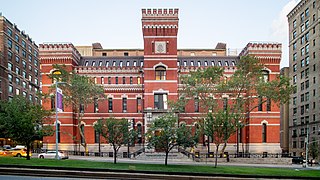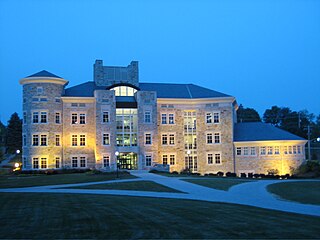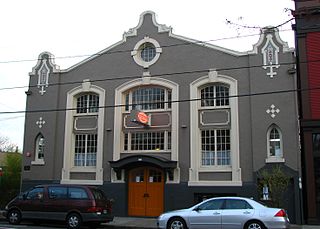
The Park Avenue Armory, also known as the 7th Regiment Armory, is a historic National Guard armory building at 643 Park Avenue in the Upper East Side neighborhood of Manhattan in New York City. Designed in the Gothic Revival style by Charles Clinton for the 7th New York Militia Regiment, the Park Avenue Armory was completed in 1880, with two expansions in the early 20th century. The building and its interior are New York City designated landmarks, and the structure was made a National Historic Landmark in 1986. Since 2006, it has been the home of the Park Avenue Armory Conservancy, which leased the building for 99 years from the New York state government. The 53rd Digital Liaison Detachment of the New York Army National Guard, the Veterans of the 7th Regiment, and the Lenox Hill Neighborhood House also occupy parts of the armory.

The Loveland Block and the Coors Building are adjacent historic storefront buildings in downtown Golden, Colorado. The Loveland Block, named for pioneer William A.H. Loveland, once served as the territorial capitol building of Colorado. Both buildings are listed on the National Register of Historic Places as a single entity.

Michael L. Benedum Hall of Engineering is a landmark academic building on the campus of the University of Pittsburgh in Pittsburgh, Pennsylvania, United States. The building was designed in the brutalist style by the architectural firm of Deeter, Ritchey, and Sippel and completed in 1971 at a cost of $15 million. The building was honored with both the Pennsylvania Society American Institute of Architects Honor Award and Distinguished Building Award. It was built with a gift from the Claude Worthington Benedum Foundation and funds from the General State Authority. It stands on a 1.8-acre (7,300 m2) site that was formerly occupied by the National Guard's Logan Armory.

The University of Wisconsin Armory and Gymnasium, also called "the Red Gym", is a building on the campus of University of Wisconsin–Madison. It was originally used as a combination gymnasium and armory beginning in 1894. Designed in the Romanesque revival style, it resembles a red brick castle. It is situated on the shores of Lake Mendota, overlooking Library Mall, and adjacent to Memorial Union.

The Armory Block is a historic commercial building at 39-45 Park Street in Adams, Massachusetts. Built in 1894-95, it is a fine example of Renaissance Revival architecture, and one of the town's most architecturally sophisticated commercial buildings. It served as the local National Guard armory until 1914, and now houses commercial businesses. It was listed on the National Historic Register in 1982.

The Jefferson–Chalmers Historic Business District is a neighborhood located on East Jefferson Avenue between Eastlawn Street and Alter Road in Detroit, Michigan. The district is the only continuously intact commercial district remaining along East Jefferson Avenue, and was listed on the National Register of Historic Places in 2004.

The United States Military Academy and grounds were declared a National Historic Landmark in 1960 due to the Revolutionary War history and the age and historic significance of the academy itself. The majority of the buildings in the central cadet area are historic.

The Main Street Historic District in Miles City, Montana comprises much of the central business district of the town, extending along Main Street roughly between Prairie Avenue and Fourth Street. It was listed as a historic district on the National Register of Historic Places in 1989.

The 369th Regiment Armory is a historic National Guard Armory building located at 2366 Fifth Avenue, between West 142nd and 143rd Streets, in Harlem, Manhattan, New York City. It was built for the 369th Regiment, also known as the "Harlem Hellfighters", founded in 1913 as the first National Guard unit in New York State composed solely of African-Americans. It later became home to the 369th Sustainment Brigade.

The Howard J. Burnett Center, also known as The Burnett Center, is an academic building on the campus of Washington & Jefferson College. This building, named after former President Howard J. Burnett, was completed in 2001 at a cost of $12.8 million. It houses the Departments of Economics and Business, Modern Languages, and Education.

The Colorado National Guard consists of the Colorado Army National Guard and Colorado Air National Guard, forming the state of Colorado's component to the United States National Guard. Founded in 1860, the Colorado National Guard falls under the Colorado Department of Military and Veterans Affairs.

The Wonder Ballroom is a music venue located in northeast Portland, Oregon. Prior to opening in 2004, the building was occupied by the Ancient Order of Hibernians, the Catholic Youth Organization, the Portland Boxing School, the American Legion organization, and a community center eventually known as the Collins Center. In 2005, the building was listed on the National Register of Historic Places as the Hibernian Hall for its "historic and architectural significance".

The United States Courthouse, previously known as Institute Hall, Opera Hall, and Memorial Hall, is a building in Natchez, Mississippi that was initially constructed from 1851 to 1853, for use as an educational building. It has served a variety of public purposes in the intervening years. It was listed on the National Register of Historic Places in 1979. In 2007, it was rededicated as a courthouse of the United States District Court for the Southern District of Mississippi.

Grays Armory is a historic building in Cleveland, Ohio. It was built by the Cleveland Grays, a private military company which was founded in 1837. This is one of the oldest standing buildings in downtown Cleveland located at 1234 Bolivar Rd.

The 23rd Regiment Armory, also known as the Bedford Atlantic Armory, is a historic National Guard armory building located at 1322 Bedford Avenue between Atlantic Avenue and Pacific Street in the Crown Heights neighborhood of Brooklyn, New York City, United States. The building is a brick and stone castle-like structure designed to be reminiscent of medieval military structures in Europe. It was built in 1891–95 and was designed in the Romanesque Revival style by Fowler & Hough, local Brooklyn architects, and Isaac Perry, the New York state government's architect.

The 14th Regiment Armory, also known as the Eighth Avenue Armory and the Park Slope Armory, is a historic National Guard armory building located on Eighth Avenue between 14th and 15th Streets in the South Slope neighborhood of Brooklyn, New York City, United States. The building is a brick and stone castle-like structure, and designed to be reminiscent of medieval military structures in Europe. It was built in 1891–95 and was designed in the Late Victorian style by William A. Mundell.

Central Music Hall (1879–1900) was a mixed-use commercial building and theater in Chicago, situated on the southeast corner of State and Randolph Streets. It was designed by celebrated German-born American architect Dankmar Adler. It was the first important building designed by the famous architect, in which he made initial use of his knowledge of acoustics. The building was demolished in 1900, around the same time Adler died, in order to build the Marshall Field & Company store, now Macy's.

Wheeler Bank is a historic building located on Manitou Avenue in Manitou Springs, Colorado built by Jerome B. Wheeler. It is on the National Register of Historic Places. Over the course of its history, the building has been a financial institution, auditorium and retail business.

44 Union Square, also known as 100 East 17th Street and the Tammany Hall Building, is a three-story building at 44 Union Square East in Union Square, Manhattan, in New York City. It is at the southeast corner of Union Square East/Park Avenue South and East 17th Street. The neo-Georgian structure was erected in 1928–1929 and designed by architects Thompson, Holmes & Converse and Charles B. Meyers for the Tammany Society political organization, also known as Tammany Hall. It is the organization's oldest surviving headquarters building.

The First Battery Armory, also known as the 102nd Medical Armory and the State Armory, is a historic National Guard armory building at 56 West 66th Street, between Central Park West and Columbus Avenue, on the Upper West Side of Manhattan in New York City, United States. The building was constructed between 1901 and 1904 and was designed by Arthur J. Horgan and Vincent J. Slattery in multiple revival architectural styles. It is composed of a symmetrical brick-and-granite headhouse to the north and a drill hall to the south. The armory is a New York City designated landmark and is listed on the National Register of Historic Places.






















